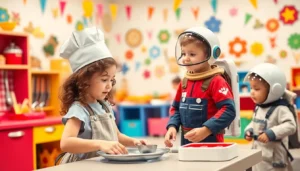Table of Contents
ToggleIn a world where kids seem to be born with tablets in their hands, play-based learning stands out as the superhero of early childhood education. Imagine a classroom where children explore, create, and learn through play—like tiny Einsteins in capes! This approach isn’t just about fun and games; it’s a powerful way to spark curiosity and foster essential skills that will last a lifetime.
Overview of Play-Based Learning Early Childhood Education
Play-based learning engages children actively in their educational journey. Research shows that this method enhances cognitive, social, and emotional development. Classrooms designed for play-based learning encourage exploration, creativity, and problem-solving skills.
Children learn through interaction with their environment and peers. For instance, building blocks foster spatial awareness and fine motor skills while promoting teamwork during group projects. Engaging in role-playing activities allows children to practice communication skills, as well as understand social roles and responsibilities.
Educators in play-based settings focus on observation and facilitation rather than direct instruction. They create rich learning environments filled with diverse materials that spark children’s interest. Creating a safe and inviting space allows kids to take risks, explore their ideas, and embrace their creativity.
Significantly, play-based learning aligns with various educational standards and frameworks, such as the Developmentally Appropriate Practices recommended by the National Association for the Education of Young Children. This approach not only meets the developmental needs of children but also prepares them for future academic success.
Parents and educators praise play-based learning for its holistic approach. Studies indicate that children engaged in this method show higher levels of engagement and motivation towards learning. Prioritizing play in early education supports lifelong learning habits, sets a solid foundation for academic achievement, and nurtures critical thinking skills.
Benefits of Play-Based Learning
Play-based learning provides crucial advantages for early childhood education. This approach cultivates a dynamic learning environment that significantly benefits children’s growth.
Cognitive Development
Cognitive skills flourish in play-based settings. Children engage in activities that challenge their thinking and problem-solving abilities. For instance, building blocks enhance spatial reasoning and creativity. Imaginative play fosters critical thinking, allowing children to explore various scenarios. Studies show that children who participate in play-based learning demonstrate improved attention spans and better memory retention. Engaging in role-playing helps them grasp complex concepts through experiential learning. Exposure to diverse play activities supports cognitive flexibility, translating to greater adaptability in future learning environments.
Social Skills Enhancement
Social skills develop rapidly through play-based interactions. Children learn to communicate effectively with peers in collaborative settings. Taking turns during games teaches patience and negotiation skills. Participating in group activities fosters empathy and understanding of different perspectives. Sharing and cooperation become integral parts of their play, reinforcing important social norms. Research indicates that children in play-rich environments exhibit stronger relationship-building skills. Forming connections with peers lays the foundation for healthy friendships and teamwork in later stages of development. Encouraging interaction among children enhances their emotional intelligence, equipping them for future social challenges.
Key Components of Effective Play-Based Learning
Play-based learning relies on various key components that enhance the educational experience for young children. Two primary aspects include child-centered approaches and the vital role of educators and caregivers in guiding the learning process.
Child-Centered Approaches
Child-centered approaches focus on the interests and needs of each child. Children actively participate in their learning through hands-on experiences and exploration. Their unique perspectives drive the thematic activities within the classroom, fostering engagement and motivation. For instance, children may choose to delve into nature, creating a project around gardening or the life cycles of plants. Such choices enhance their problem-solving skills and critical thinking abilities. Play-based learning environments further encourage autonomy, enabling children to take ownership of their learning journeys.
Role of Educators and Caregivers
Educators and caregivers play a crucial role in facilitating effective play-based learning. Instead of directing activities, they observe children’s interactions and interests, guiding them through the learning process. This observational approach allows for tailored support based on individual needs. For example, during group play, educators might encourage teamwork by promoting collaborative projects that involve multiple children. Assessments based on interactions help identify developmental goals, keeping lessons aligned with educational standards. Strong relationships fostered by educators create safe spaces where children feel confident to explore and learn.
Challenges in Implementing Play-Based Learning
Implementing play-based learning in early childhood education presents several challenges that educators and institutions encounter.
Institutional Constraints
Limited funding often hinders the development of play-based learning environments. Many institutions struggle to allocate resources for materials, training, and space needed for effective play-based setups. Regulations sometimes create barriers, as standardized testing pressures educators to prioritize traditional teaching methods over play. Moreover, teacher training programs may lack sufficient focus on play-based strategies, leaving educators unprepared for this approach. Schools may face overcrowded classrooms, making it difficult to provide individualized attention during play activities. Commitment from administration remains essential to overcome these institutional constraints and foster a play-centric culture.
Parental Concerns
Parents frequently express concerns regarding the educational validity of play-based learning. Many worry that play lacks the rigor needed for academic achievement. Misunderstandings about the nature of play can also lead to skepticism; some parents may believe that play equates to unstructured time rather than meaningful learning. Parents often seek evidence of measurable progress, which can conflict with the more subtle gains observed in play-based environments. Providing resources and information about the benefits of play is crucial for addressing these concerns. Engaging parents in the learning process can help build trust and support for play-based methodologies.
Successful Case Studies in Play-Based Learning
Numerous schools exemplify effective play-based learning strategies. For instance, the Reggio Emilia approach in Italy emphasizes community, fostering collaboration among children, teachers, and families. This model highlights children’s interests, using them as pathways for exploration and discovery in an engaging classroom.
Another notable example comes from the High/Scope Educational Research Foundation in the United States. This program utilizes a structured yet flexible curriculum that promotes active learning. Children engage in plan-do-review cycles, allowing them to make choices about their activities while reflecting on their experiences. Research shows students in High/Scope classrooms demonstrate enhanced problem-solving abilities and social skills.
In Australia, the national curriculum encourages educators to integrate play-based learning across various subjects. Schools report marked improvements in children’s engagement levels and self-regulation skills when they participate in play-oriented activities. This shift in educational philosophy fosters inquiry and creativity, vital components for success in today’s world.
Numerous early childhood centers are adopting play-based methods, yielding positive outcomes. For example, teachers at a local preschool noted that children exhibit improved language skills and emotional intelligence following a transition to play-driven curricula. Observations indicate that interactions during play encourage expressive language and cooperative behaviors among peers.
Collaborative projects also serve as successful case studies in play-based settings. One school created a community garden project, encouraging children to learn about ecology through hands-on experiences. Children learn teamwork while nurturing plants, which positively impacts their understanding of interconnectedness within their environment.
These examples underscore the effectiveness of play-based learning. Results from various studies show children engaged in play-based settings exhibit greater enthusiasm for learning and demonstrate essential cognitive and social skills. This approach prepares children not only for academic success but also for a lifetime of meaningful relationships and adaptability.
Play-based learning stands as a transformative approach in early childhood education. It nurtures children’s curiosity and creativity while equipping them with vital skills for their future. By fostering an environment where exploration and interaction thrive, children develop cognitive, social, and emotional competencies essential for lifelong success.
Educators play a crucial role in this process, guiding rather than directing, and creating safe spaces for learning. Despite challenges like institutional constraints and parental skepticism, the benefits of play-based learning are clear. Through successful models and case studies, it’s evident that this method not only enhances academic readiness but also cultivates meaningful relationships and teamwork skills. Embracing play as a core component of education can lead to a brighter future for children.










